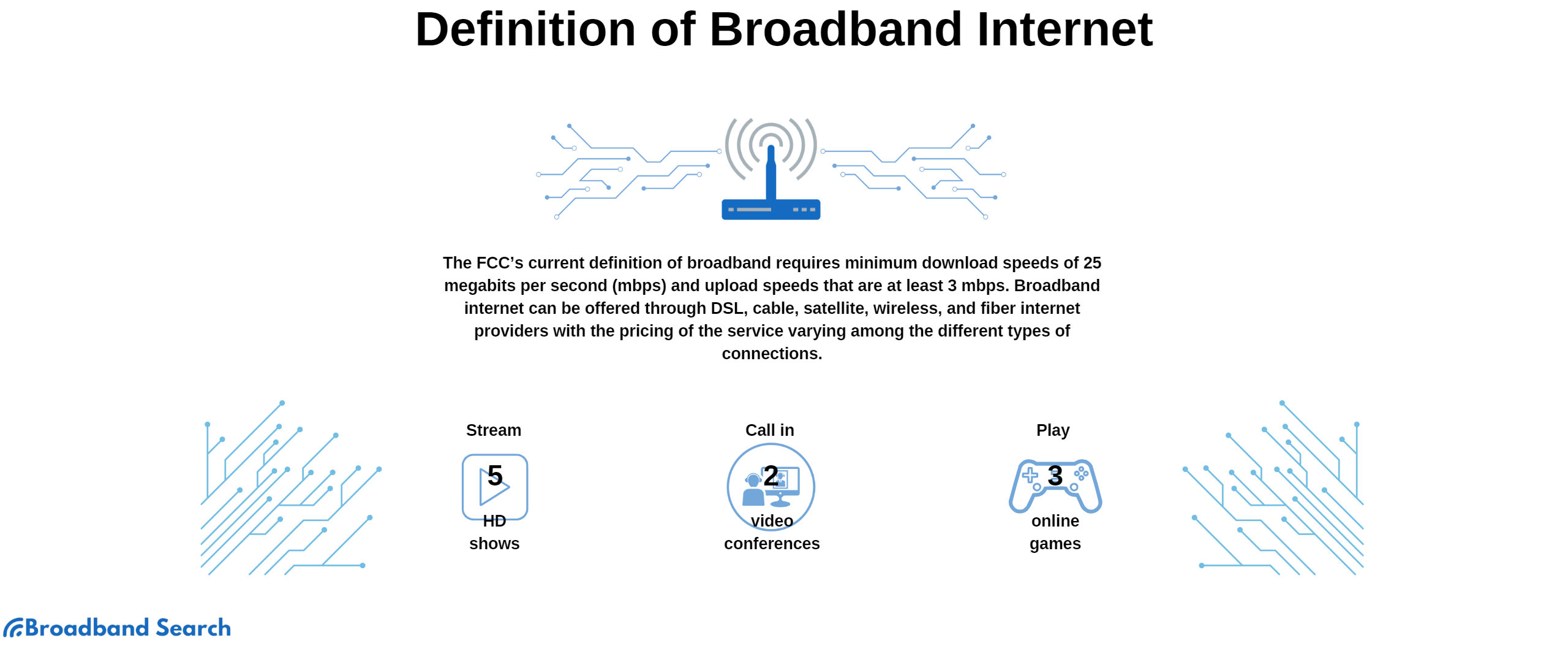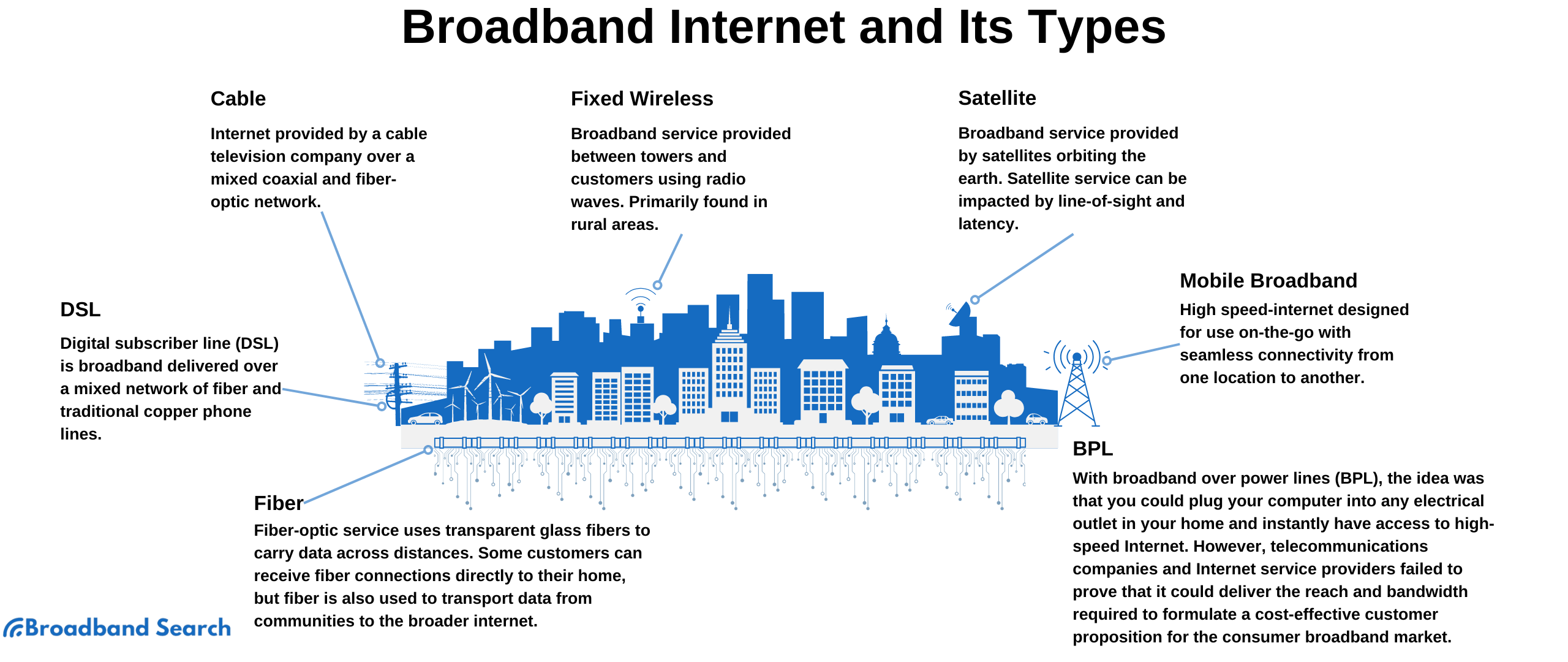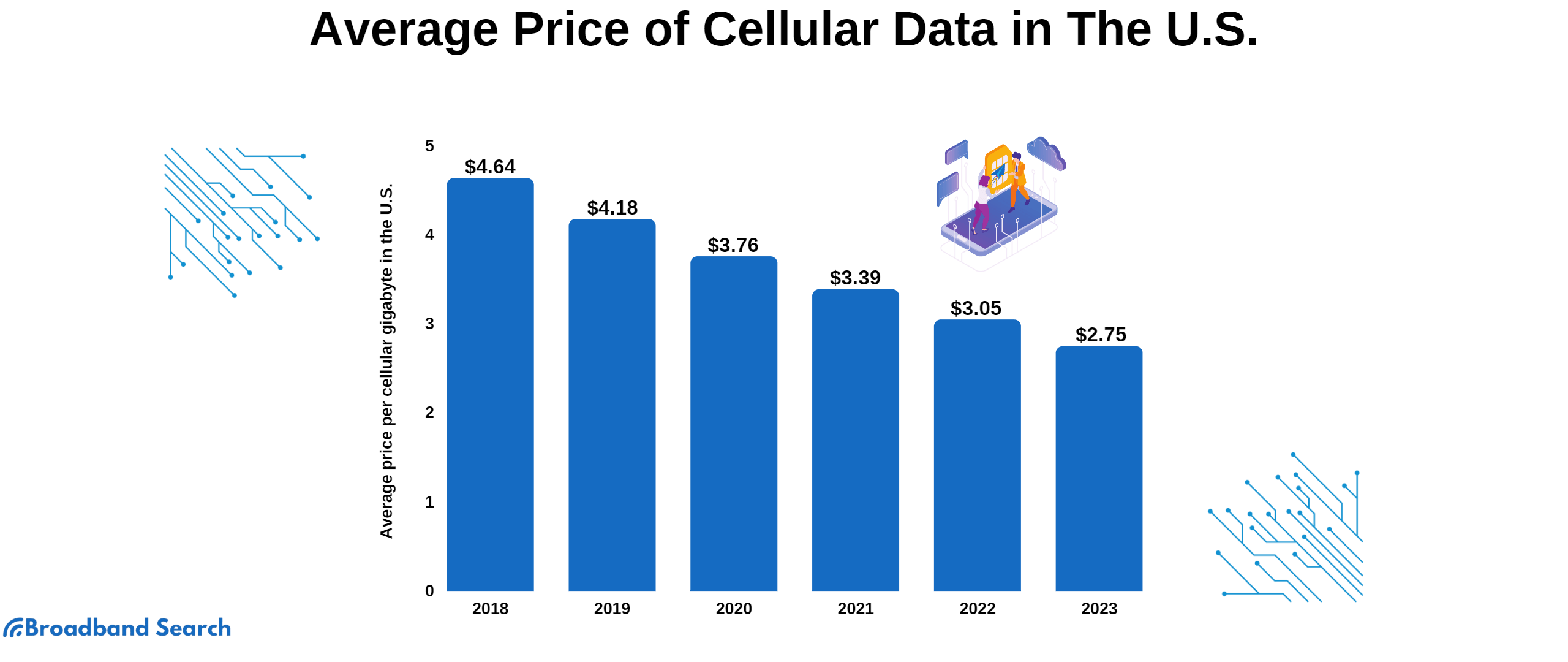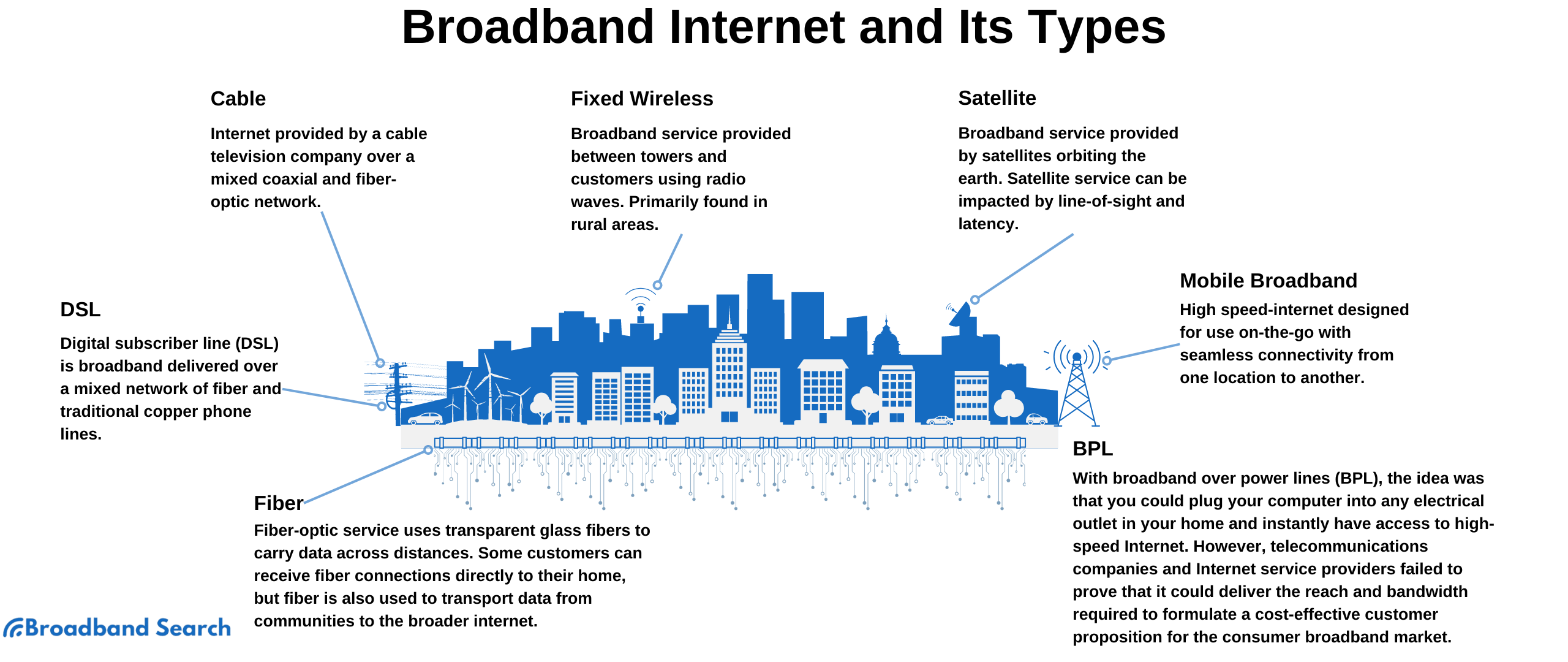Most of us have heard of “broadband,” but we never really know how to explain what it is when someone asks. What is a broadband internet connection, anyway? What are all the different types of broadband connections, and how do they work?
Get ready to say goodbye to any confusion around broadband internet connections. We will discuss its history, give a detailed explanation, and go over the different types of broadband internet connection. So sit tight, and let's get started.
What is Broadband Internet?
Broadband refers to high-capacity transmission technologies that can transmit data, voice, and video at long distances and high speeds. Common mediums of broadband include coaxial cables, fiber optic cables, and radio waves.

Nowadays, more precise definitions of broadband are usually required. For a service to be classified as broadband internet by the Federal Communications Commission (FCC), providers must offer speeds of at least 25 Mbps when downloading and 3 Mbps when uploading data.
More and more Americans are realizing just how crucial a high-speed internet connection is for work, school, and health care. The FCC reports that between 2020 and 2021, there was a 26.6% increase in people downloading content from the internet, with 49% of people uploading content. Even so, data suggests that 24 million Americans still lack access to basic high-speed broadband connections.
The FCC considered changing the definition of broadband to 100 Mbps of download and 10 Mbps of upload speed. However, they decided not to go through with it over worries about whether there are sufficient ISPs who can meet the new standard.
To bridge this gap, in November 2021, President Joe Biden signed into law the $1.2 trillion Infrastructure Investment and Jobs Act which sets aside a total of $65 billion to improve internet access in both rural areas and among low-income families so that "every American has access to reliable high-speed Internet".
Broadband vs Dial-Up: Which is Better?
The long-standing debate of broadband or dial-up rages on, but the answer is not as black and white as you may think. Some people prefer a broadband connection for its reliability, while others find dial-up more straightforward.
It all ultimately comes down to what will work better for you. Let us review their key differences to help make your decision easier.
Dial-Up Internet
Remember the good old days when people had to use dial-up? If you wanted to make a phone call and someone else was already using the internet, you were out of luck! Those were the days before Wi-Fi or hotspots. The entire connection was monopolized by the internet. There were no mobile phones back then, so people had to choose between making a phone call or going online.

So how exactly does a dial-up work? When you have a dial-up internet connection, your modem sends and receives data through a landline. When you activate the service, your modem gets in touch with another modem at your ISP to start the connection. Therefore, when you use dial-up internet, it's using your copper telephone line to communicate data instead of just voice — which is why you hear a phone dialing sound as well as a high-pitched noise while logging on.
Although a dial-up connection is cheaper and more secure than other types, its slower speed can make it difficult to watch videos or download media files difficult. For example, opening email attachments or playing online games takes much longer with this type of connection.
The largest drawback, however, is that you can only utilize the telephone and internet at one time. Once a connection is made, it occupies the entire telephone line for the duration of your Internet session.
This could prove problematic if there's only one phone line in a home because an active internet connection operates similarly to a regular phone call. Depending on who your service provider is, this might mean being charged for however long you spend online. These shortcomings are what caused dial-up's downfall between 2004 and 2005.
Even though this is the case, plenty of homes still use dial-up services. A 2017 statistic revealed that 0.3% of Americans (around 977,000) still have a dial-up connection.
Broadband Internet
The early 2000s called for an upgrade from the regular dial-up internet, and broadband internet was born. Its speedy connections made it much simpler to download & send files. Plus, once it's installed, your broadband is always on – meaning you never have to wait for it to connect! By early 2007, almost half of all internet users had a broadband internet connection.
With a broadband connection, you can use your phone and browse the internet simultaneously because it uses a separate line that is only used for data transmission. There are many types of broadband connections like those that use copper phone wires (DSL), coaxial cable television wiring (cable), fiber-optic cables (fiber), and wireless options like satellite or 4G/5G LTE.
Over time, dial-up has become outdated, and its demise is a result of the simple fact that broadband is just better in almost every aspect - speed, price, reliability, convenience — you name it. Let's explore some of these advantages further.
- Speed is one of the key advantages of using a broadband internet connection. Download speeds are faster, and there's also more than enough bandwidth to support large streams.
- A landline is not required to connect you to your ISP. This means that important phone calls from friends or family can come through any time of the day without worrying that the line is busy.
- You are continuously connected to your broadband. Thus, you eliminate the need to constantly reconnect to the internet and avoid wasting time with busy signals.
However, one of the major issues with a broadband connection is that it can be quite expensive to use. You may have to pay $35 - $90 per month just to access the internet, which can be a real problem if you're on a budget.
Additionally, security concerns are always present when using a broadband connection. If you want to keep your computer safe while online, you'll need to purchase and install a firewall protection system.
While there may be some disadvantages to having a broadband connection, the advantages often outweigh them. In this battle, it is clear that broadband is the winner.
Broadband Internet Explained and Types Organized
With so many broadband internet options available, choosing the best one for your specific needs can feel overwhelming. To help you make an informed decision, we’ve broken down the key types of broadband connections and organized them for easier understanding. By the end of this guide, you'll know which connection type suits your lifestyle, location, and internet usage.

1. Digital Subscriber Line (DSL)
Pros:
- Affordable for budget-conscious users.
- Utilizes existing telephone lines, making it accessible in many areas.
Cons:
- Internet quality depends on your Proximity to the service Provider.
- May include bundled telephone services, which can be inconvenient if you don’t need a landline.
Speeds/Pricing:
- 1–8 Mbps, depending on the package
- Average monthly cost: $50.57
Recommended for:
Homes and individuals looking for budget-friendly internet suitable for basic tasks like browsing and streaming.
1.1 Asymmetric Digital Subscriber Line (ADSL)
Pros:
- Perfect for browsing, streaming, and other leisure activities.
- Allows simultaneous use of phone and internet services.
Cons:
- Slower upload speeds can be frustrating for users who frequently send large files.
Recommended for:
Casual internet users who enjoy watching movies, listening to music, and social media.
1.2 Symmetric Digital Subscriber Line (SDSL)
Pros:
- Equal upload and download speeds, ideal for two-way activities.
- Previously favored by small businesses for reliable uploads and downloads.
Cons:
- Largely obsolete, replaced by faster options like fiber and cable broadband.
Recommended for:
Not ideal for modern internet needs due to outdated technology.
| Type | Download Speed | Upload Speed | Avg. Cost | Availability |
|---|---|---|---|---|
| DSL | 1–8 Mbps | 1–3 Mbps | $50.57/mo | Widely available, urban &s; suburban |
| ADSL | 1–8 Mbps | Lower than download | $50–60/mo | Urban &s; suburban |
| SDSL | Equal up/down | Equal up/down | $50–60/mo | Largely obsolete |
2. Cable Internet
Pros:
- Delivers high speeds, supporting multiple devices and activities like streaming or gaming.
- Often bundled with TV packages for added savings.
Cons:
- Shared bandwidth can lead to slower speeds during peak hours.
- Limited accessibility in rural areas.
Speeds/Pricing:
- 3–500 Mbps
- Average monthly cost: $51
Recommended for:
Light to moderate users in urban or suburban settings who enjoy streaming, browsing, and occasional gaming.
| Type | Download Speed | Upload Speed | Avg. Cost | Availability |
|---|---|---|---|---|
| Cable | 3–500 Mbps | 1–50 Mbps | $51/mo | Urban &s; suburban |
3. Satellite Internet
Pros:
- Accessible in rural and remote areas.
- Doesn’t require physical cables for setup.
Cons:
- Higher latency due to distance data travels.
- Signal can weaken during bad weather.
Speeds/Pricing:
- Download speeds: ~31 Mbps
- Average monthly cost: $110
Recommended for:
Rural residents with limited internet options aside from dial-up.
| Type | Download Speed | Upload Speed | Avg. Cost | Availability |
|---|---|---|---|---|
| Satellite | ~31 Mbps | ~5–10 Mbps | $110/mo | Rural/remote areas |
4. Wireless Internet (Not Wi-Fi!)
4.1 Fixed Wireless
Pros:
- High speeds and no data caps.
- Suitable for homes in rural areas with limited cable or fiber options.
Cons:
- Performance may suffer in urban areas or locations with obstructions.
Speeds/Pricing:
- 100–400 Mbps
- Prices start at $15, varying by Prosvider
Recommended for:
Rural homes and larger households needing high-speed internet without cables.
4.2 Mobile Wireless
Pros:
- Portable and functional for smartphones and tablets.
- Easily switches between cellular towers for connectivity.
Cons:
- Data caps and throttled speeds can make it less cost-effective as a primary connection.
Speeds/Pricing:
- 4G: ~15 Mbps
- 5G: 47–58 Mbps
- Mobile data: ~$3 per GB
Recommended for:
Travelers, mobile workers, and users in areas without fixed service.

| Type | Download Speed | Upload Speed | Avg. Cost | Availability |
|---|---|---|---|---|
| Fixed Wireless | 100–400 Mbps | 50–100 Mbps | $15+/mo | Rural areas |
| Mobile Wireless 4G | ~15 Mbps | 5–10 Mbps | ~$3/GB | Nationwide |
| Mobile Wireless 5G | 47–58 Mbps | 20–50 Mbps | ~$3/GB | Select urban/suburban areas |
5. Broadband over Power Line (BPL)
Pros:
- Uses existing electrical lines for internet transmission.
Cons:
- Limited reach and low bandwidth compared to other methods.
Recommended for:
Formerly a good option; now considered obsolete.
| Type | Download Speed | Upload Speed | Avg. Cost | Availability |
|---|---|---|---|---|
| BPL | ~1–10 Mbps | ~1–5 Mbps | $40–50/mo | Limited/obsolete |
6. Fiber-Optic Internet
Pros:
- Speeds up to 1 Gbps for lightning-fast uploads and downloads.
- Highly reliable and less Prone to slowdowns.
Cons:
- Requires extensive infrastructure, limiting availability in rural areas.
- Higher upfront costs due to installation fees.
Speeds/Pricing:
- Average monthly cost: $63.78
Recommended for:
Smart homes, remote workers, and anyone who heavily relies on high-speed internet for data-heavy tasks or multiple devices.
| Type | Download Speed | Upload Speed | Avg. Cost | Availability |
|---|---|---|---|---|
| Fiber | Up to 1 Gbps | Up to 1 Gbps | $63.78/mo | Urban/suburban (limited rural) |
The Bottom Line: Dial-Up is Out, Broadband is Here to Stay
Although dial-up was once the go-to for internet usage, it is now a dying technology, and broadband internet connection is here to stay. You can find broadband networks in nearly every community across America. Not only do consumers prefer broadband services, but governments have also thrown their support behind this kind of Internet access.
We expect global average broadband speeds to double in the next few years. By 2023, the average speed is expected to be 110.4 Mbps, up from 45.9 Mbps in 2018. With such an increase, many people will enjoy much faster internet connections and be able to take advantage of new online opportunities.
So what are you waiting for? If you're still using dial-up, it might be time to upgrade. Broadband internet connection is the way of the future and offers speeds that are unrivaled by other connection types.
Plus, there are six main types of broadband technologies: DSL, cable, satellite, wireless, BPL, and fiber. There's bound to be one that perfectly meets your needs—whether for leisure or work! So what are you waiting for? Upgrade today and join the rest of us in the 21st century!
FAQ
Is broadband installation free?
Broadband installation is generally free, depending on the service provider, the type of deal selected, and the location.
How long does it take to install home broadband?
Although the average internet installation time is two weeks, several additional factors can cause delays to your broadband setup, such as your chosen provider, whether you need a new phone line installed, and where you live.
Does broadband work without electricity?
Wireless internet is only as strong as its connection to power. So, if there's a power outage, your devices that need it like routers will stop working and you'll lose access to the internet.
Are broadband and Wi-Fi the same thing?
Broadband is an internet connection given by your service provider while Wi-Fi is the technology you use to connect to that broadband and access the internet.
Is it okay to leave Wi-Fi on all the time?
Yes, the engineers who create internet routers design them to be always available so that you can have internet access whenever you need it.

